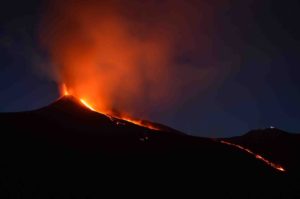
Geoscientists from Michigan Technological University, University of Wisconsin Oshkosh and ETH Zurich have traced the age and chemical signatures stored in tiny zircon minerals to examine the recycling of carbon from the mantle to the surface through time.
A better understanding of these changes in carbon recycling help improve models about how the planet’s early processes transitioned from the cold Snowball Earth with near-global ice cover into more temperate swings between ice ages and warming periods. The team’s research will be published in Nature Geoscience next Monday.
“The geochemistry reflects a disequilibrium—and the Earth has to expel all of that to try to get back to equilibrium,” says Chad Deering, one of the co-authors and an assistant professor of geology at Michigan Tech. “What we propose is that a series of events had to coincide to ultimately lead to the optimal conditions required to release an anomalous amount of carbon.”
The chemical change is recorded on the scale of continents, but the details of that continent-building are locked in the layer-by-layer crystal structures of tiny zircons gathered from Antarctica. Some of the minerals are smaller than 100 microns, barely the width of an average human hair.
“We focused on looking at the trace elements in those zircons,” Deering says. “There’s a classification scheme that we use to determine the original rock type that the mineral grew in, which then tells us what kind of magma left that particular chemical signature of trace elements.”
The ETH Zurich lab then used uranium-lead dating to determine how old the samples are. Given the dates and trace elements, what Deering and his team observed is a peak in carbon-emitting magma types that occurred between 500 to 700 million years ago during the Ediacaran period. What that means is that a significant amount of carbon was likely released.
Volcanoes emit a lot of carbon dioxide—some much more so than others. Alkaline volcanoes like Mount Etna in Italy and Mount Erebus in Antarctica dwarf the carbon output of other volcanos by 10 to 50 times. And it’s the same type of volcanism that was identified in the zircons studied by Deering.
“Alkaline magmas are produced by melting just a little bit of the mantle,” he explains, adding that while rare and small in volume, their importance is in the amount of carbon dioxide belted out and the special conditions they form under. “What happens as subduction occurs is that the mantle becomes ‘polluted’ with volatile material from the Earth’s surface—water, carbon, sulfur.”
The changes leading up to this significant event are slow—occurring over hundreds of millions of years—and have major consequences. As the Earth cools through time and the mantle becomes increasingly more polluted, it will eventually generate alkaline magma that can erupt at the surface. The cooler subduction and mantle pollution can produce rocks known as blueschists, well-documented in the rock record during the Ediacaran period, along with alkaline volcanism. Following the pulse of carbon-rich volcanism, atmospheric carbon dioxide spikes, which is also recorded in the carbon isotope record, accompanied by a warming period. All told, this series of events gave rise to the atmosphere and geological cycles that shaped the planet as it is today.
“To create a timeline, we needed to have dates on a significant number of zircons spanning many hundreds of millions of years,” Deering says. “In essence, we discovered that throughout the Earth’s history there was a particularly significant pulse of carbon emitted that immediately preceded the Cambrian explosion, the most important emergence of life that has yet to occur.”
Gleaned from tiny zircons, the team used the chemical signatures of ancient volcanoes to establish that a series of fortunate events occurred as the oldest continents were constructed and materials recycled from the surface to eventually shape our modern carbon cycle.
Reference:
Timothy Paulsen et al, Evidence for a spike in mantle carbon outgassing during the Ediacaran period, Nature Geoscience (2017). DOI: 10.1038/s41561-017-0011-6
Note: The above post is reprinted from materials provided by Michigan Technological University.









